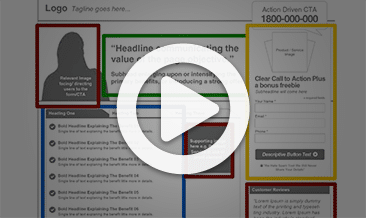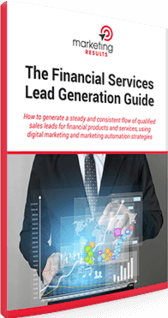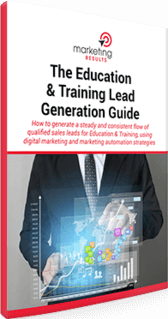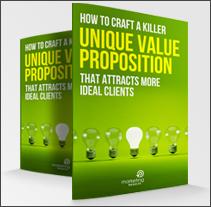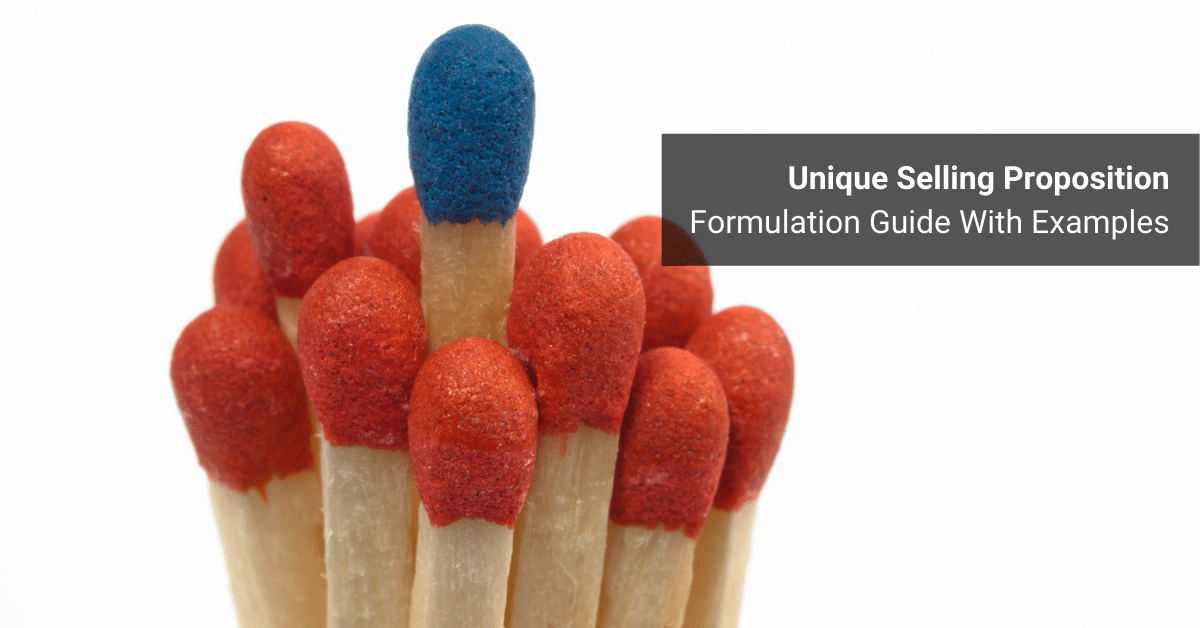
You may already know that having a compelling Unique Selling Proposition (USP) for your business is the cornerstone of successful marketing.
In this guide, we’ll unpack successful USP statements and show you how to formulate one for yourself.
Let’s start with one of the most famous examples of all:
Pizza aficionados might disagree but, when it comes to delivery and ‘mass market’ pizza, there’s not a big difference in quality between the major players.
I’m confident a blind taste test would prove my point.
To be successful, a pizza company must differentiate itself from the other pizza companies by positioning themselves as better and different.
A small company in the United States faced this differentiation challenge in the 1960s. Tom Monaghan had bought his brother’s share of Domino’s Pizza (for a used Volkswagen Beetle) and was sleeping on a cot in the store.
At the time, Domino’s was just another pizza restaurant in Michigan. Monaghan needed to increase revenue and he wanted to grow a franchise. To make Domino’s stand out from the competition, Domino’s came up with a promise:
Pizza delivered in 30 minutes or it’s free.
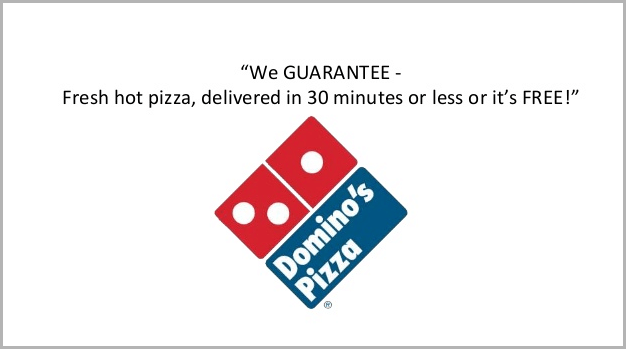
Source: SlideShare
In 2009, Domino’s reported $1.4 billion in revenue.
People in the shipping and logistics business might disagree, but there is little difference between the major shipping companies to the average person in the street who wants a package or letter delivered overnight. FedEx recognised this and, like Dominos, came up with a promise.
When it absolutely, positively has to be there overnight.
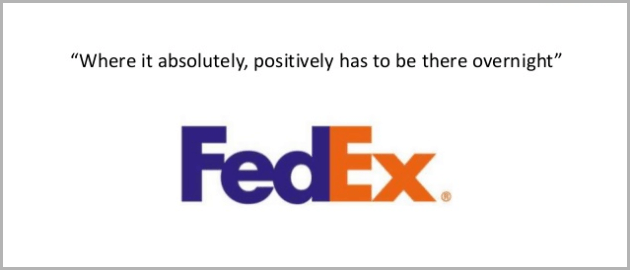
Source: SlideShare
FedEx went from being a small courier service based in Tennessee to one of the largest companies in the world; its airplanes travel nearly 500,000 miles a day.
When a potential customer decides to order a pizza, they’ve already decided to buy a pizza. The question becomes, “which pizza company?”
When somebody needs to ship a package across the country, and it has to be there tomorrow, they’ve already decided to ship the package. The question becomes, “which shipping company?”
Domino’s and FedEx succeeded and grew rapidly in part because they made a promise to their customers and kept the promise. In marketing, we call this promise a Unique Selling Proposition (USP).
What is a USP? What’s its meaning?
Unique Selling Proposition Definition: A USP is that “distinct, appealing idea that sets you apart from every other “me too” competitor or alternative solution (including the alternative of doing nothing)”.
The USP places a product or service as unique and desirable in the eyes of prospects and customers.
The USP is the foundation of a marketing strategy for any company. It forms the foundations for the creation of all marketing collateral: ads, landing pages, content, keywords, audiences, podcasts, and more.
Every company that wants to be successful MUST have a clear USP.
Almost every day, I’m reminded of the importance of how vital a USP is to the success of every marketing project. A great USP with average execution can succeed, but a weak USP with superb execution usually fails.
When I ask a prospective client, “what’s your USP?”, I usually get this reply:
“What does USP stand for?”
I recently spoke to 165 business owners at an online marketing seminar; fewer than 10 of the attendees were able to state their USP.
That’s the bad news. The good news is that each of these 165 business owners could quickly answer these questions:
- What are the strengths and weaknesses of your competitors?
- Why do repeat clients and customers like you?
- What makes you better than your competitors?
If you can answer these questions, you can develop a USP.
You know what makes your company different and better but, you must communicate this to prospects. It takes a little time to develop a USP but there’s no cost; the USP is of particular importance for digital marketing.
Why Should Someone Choose You?
Visitors to your website usually arrive through a search engine, be it organically or via a pay-per-click or display ad.
Let’s say a man has decided to buy his loved one a diamond necklace. He’s already decided to buy so now the decision becomes, “which jewellery store is going to get my business?”
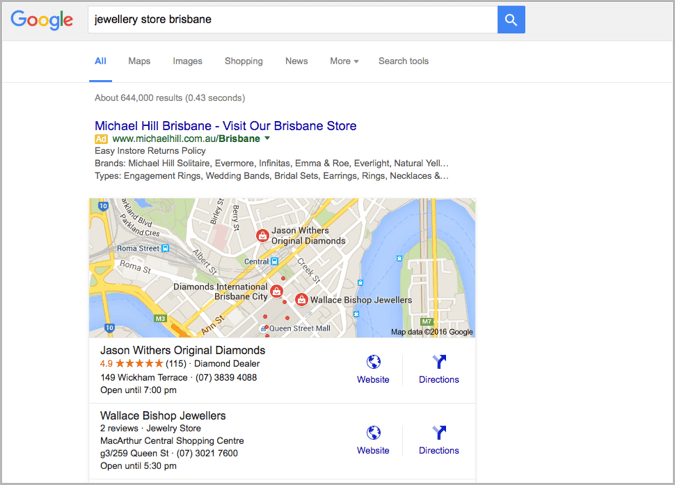
If you’re in the diamond necklace business and you’re one of the websites the man is visiting, your competitors’ sites are just a click away. So it’s vital to differentiate your jewellery store quickly so they choose you and click around your site and ultimately click ‘buy now’ on your website instead of leaving and purchasing on another site.
Leave Price Wars Behind
One of the major benefits of a strong USP is that it can help you get out of a price war.
Yes, some people shop purely for price and ‘the absolute lowest prices’ can be a USP, but let’s take a look at Domino’s and FedEx. These companies stress a benefit, not price. Yes, price is important but it’s not the only factor in a buying decision.
When you position yourself correctly, you can charge more.
For example, let’s say you’re in the public golf course business, which can be extremely competitive.
You’re in a suburb and there are five golf courses near yours, so there’s a brutal price war going on and you’d like to get out of the battle. Golfers always comment on the quality of the greens at your course. A strong USP could be:
Rolling Lakes Country Club has The Best Greens in the South Ridgewood area.
Golfers value great putting surfaces and would be willing to pay for a course with excellent greens. In the New York City area, where golf can be funereally slow, especially on weekends, a course guarantees “a round of golf in four hours or less or your next green fee is on us.” It’s a highly successful USP.
But, “what about a strong brand”, I hear you say …
A Strong USP is Much More Important (and Profitable) than Branding
If you’ve read marketing books, been to conferences, or sat down with a marketing or advertising consultant, you may have heard the word ‘branding’.
For small business owners, it’s an extremely dangerous word: you can quickly waste tens of thousands of dollars on branding at the recommendation of a branding consultant or advertising agency that uses words like ‘brand-centric’ or similar nonsense.
Ask a branding agency or a branding consultant about results. Ask them to show you the actual revenue their latest ‘branding’ campaign produced.
If you’re an owner or a marketing manager at a small or mid-sized business, be extremely wary when you hear amorphous marketing chatter about “building your online brand” and “leveraging brand equity”.
It’s tempting to listen to the branding experts and hand them money.
After all, big companies spend money on branding so it must produce an ROI, right?
Let’s take a quick look at branding and what it really means.
To “brand” a product or service is to imprint your mark on it.
Branding started in order to differentiate items that looked similar… like one farmer’s horses and a neighbour’s.
These days, however, the goal of branding is to increase awareness.
Companies pour money into branding campaigns because they want to imprint the brand into the mind of the consumer, increase awareness, and create a certain feeling.
The hope is that when it’s time to make a buying decision, the consumer will recognise the brand, like its associations, remember the funny ad he or she saw on TV last night, remember the ‘certain feeling’ that ad gave them and buy ‘Brand X’ over all the other brands.
Although it’s difficult to measure, branding can be effective for large companies that sell a mass-market service or product. And you must have deep, deep pockets to buy TV time and radio spots plus big ads in newspapers and magazines.
In one of his blogs, Dan Kennedy, widely regarded as one of the top small business marketing experts (and an excellent marketer himself), writes:
“I do counsel AGAINST investing directly into brand-building, especially with large-company style ‘image’ advertising that cannot be accurately and ruthlessly held accountable.”
Kennedy has a brand called “No B.S. Marketing” but it’s not where Kennedy spends his marketing money. And Dan Kennedy’s brand is Dan Kennedy.
Kennedy has a logo with him standing behind a bull. That’s about it for Kennedy’s branding.
Highly successful direct response copywriter and marketing consultant Bob Bly, who is no great fan of branding, wrote a blog titled “Is Madison Avenue a Big Fraud?”
In the blog he talks about an advertisement for Six Flags, a chain of American amusement parks. The ad is set in a town where everyone is so busy working they have no time to have fun.
Up rolls a Six Flags bus and out pops an old man who starts dancing wildly. All the people in the town get on the bus, go to Six Flags and have a great old time. Bly said the ad world acclaimed the ad for its “humour, energy, and cleverness.”
According to Bly, who cites Parade magazine, the ad campaign cost $72 million yet generated no increase in attendance and “not a drop of added revenue”.
Look up Six Flags on Wikipedia and you’ll discover the New York Stock Exchange delisted the company in April 2009 and it filed for bankruptcy on June 13 the same year (although has since become solvent and operational again, after a period of struggle).
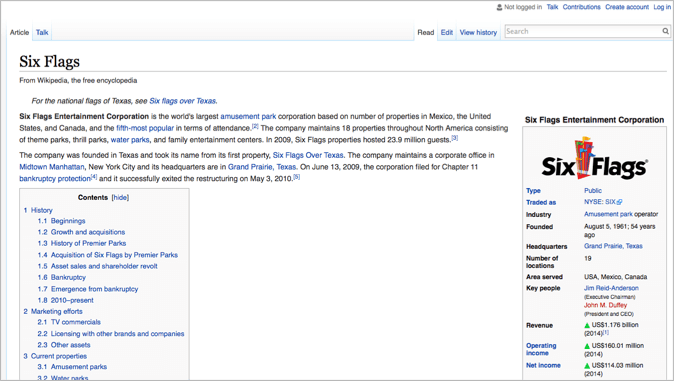
If you’re still in doubt about branding, watch a YouTube video comparing direct response (measurable) advertising to general (branding) advertising.
The star of the video? David Ogilvy, one of the most famous and successful advertisers in the history of advertising.
General advertisers know almost nothing for sure because they cannot measure the results of their advertising.
I’m not bashing branding and the merchants of branding because I dislike branding experts. I can think of at least two that I like. I’m bashing branding because I don’t want you to waste your money on branding.
Yes, a branding agency may win awards at advertising awards dinners and a campaign may temporarily (and expensively) build awareness, but it won’t produce what every small business needs: a daily torrent of qualified leads.
Branding will not help you get these leads.
We prefer to invest every marketing dollar and every ounce of mental RAM generating qualified sales leads instead of building awareness.
Do You Want Customers to “Be Aware” or Do You Want them to Buy?
Instead of branding, start by positioning your product or service in the mind of potential customers.
What A USP Is… And What It Is Not
A USP is not a tagline/slogan and a tagline/slogan is not a USP.
A tagline is a short sentence or phrase that’s often part of, or next to, a logo. Here are some examples of taglines:
- VB: For A Hard Earned Thirst
- Weetbix: Aussie Kids Are Weetbix Kids
- The Burgers Are Better At Hungry Jacks
- AAMI: Lucky You’re With AAMI
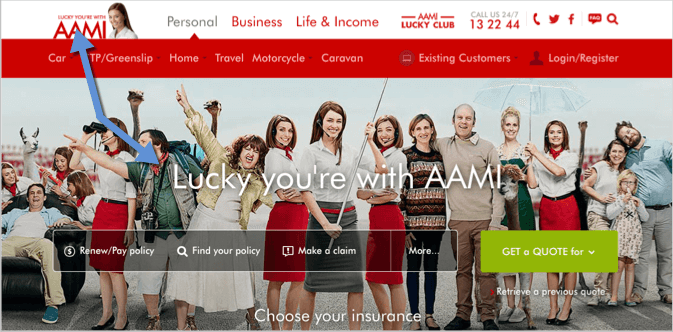
Source: AAMI
A tagline is NOT the same as a USP. Your tagline is usually too short to communicate your entire USP.
However, a great tagline quickly summarises the full USP and communicates the key selling proposition in one or two seconds.
A USP can be a few words or it can be full paragraph. Defining then encapsulating what makes you different, unique, and desirable is more important than the word count.
Remember, a successful USP answers this question: why should a potential client or customer buy from you?
When answering this question, promise something special your competitors cannot deliver.
9 More Unique Selling Point Examples
Before we create your USP, take a look at these excellent examples.
- Dominos: Pizza delivered in 30 minutes or it’s free.
- FedEx: When it absolutely, positively has to be there overnight. (Signifies speed)
- Woolworths: The Fresh Food People (Signifies quality and selection)
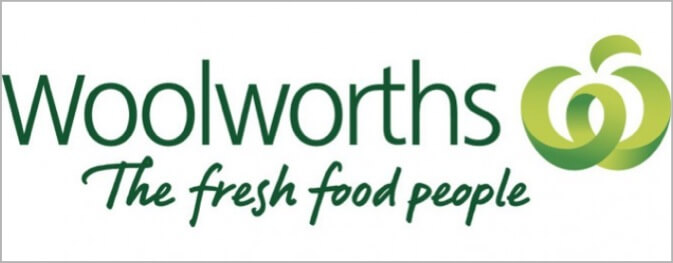
Source: Woolworths
- Craftsman Tools: If any Craftsman hand tool fails to provide complete satisfaction, return it for free repair or replacement. Period. The first Craftsman hand tool we sold back in 1927 is still under warranty today. (Signifies peace of mind via a guarantee)
- M & M’s: The milk chocolate melts in your mouth, not in your hand.
- Southwest Airlines: We are the low-fare airline.
- OPSM: Every member of the OPSM family cares deeply about eyes, our most precious natural assets. Our company creates career opportunities for those who love eyes too; and we work with communities, charities and sportspeople to improve vision while promoting the critical importance of good eye health.
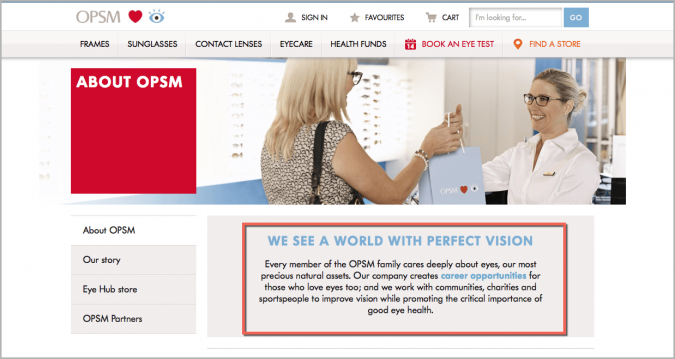
Source: OPSM
- Zappos: The best return policy ever. A return policy that removes the fear of buying online and buying shoes that might not fit.
- Dropbox: Dropbox keeps your files safe, synced, and easy to share. Bring your photos, docs, and videos anywhere and never lose a file again.
Just as some taglines are poor, many USPs are awful. These approaches are too vague, and not unique.
- “Good Quality and Low Prices.”
- “Affordable Quality Since 1984.”
- “Service With A Smile.”
- “Excellence In Quality And Service.”
These USPs are commonplace and they scream, THESE COMPANIES KNOW NOTHING ABOUT MARKETING AND ARE DOOMED TO FAIL.
How To Write A Unique Selling Proposition
Now you know what a good USP looks like (and a bad one), here are four steps to creating a bulletproof USP.
Step One: Choose your category.
USPs are grouped into one of these:
- Price.
- Quality.
- Service.
- Speed.
- Selection.
- Convenience.
- Guarantee.
- Customisation.
- Originality.
- Specialisation.
Step Two: Crystallise and communicate your unique strengths
Ask yourself these four questions:
- What do you offer that your competitors don’t?
- Is #1 important to your customers?
- How easy is it for competitors to copy?
- Can it be communicated easily?
Ask your current clients and customers what they like about your products and services.
Step Three: Flesh out the concepts.
These concepts are broad.
For example, if you choose ‘Service’ as your category, you have to say more and be more specific than “We Give GREAT Service.”
This type of cliché will not convince someone to stay on your website.
Step Four: Lay on the proof.
We use these steps with our clients before we take any of the other steps necessary to generate leads.
Here is EXACTLY how to create a unique selling proposition summarised in an infographic;

How A Bumper Sticker Company Increased Online Sales By Over 800%
How Would You Like an 800% Increase in Sales?
We built a USP for a client who sells stickers, primarily customised bumper stickers.
We proved that even a product as seemingly simple as a sticker can benefit from a USP.
Here’s how we answered the USP formation questions.
What they offer: Customized Stickers offer low prices on full colour stickers, but they also include added benefits at no extra charge… a free artwork service, unlimited colours, plus UV-resistant coatings.
Is it important to the customer? Yes.
Stickers are a “commodity” item and customers are typically price-sensitive.
Many potential customers resent the extra cost and inconvenience of getting artwork designed separately. All-in-one pricing is simpler and more transparent; customers like the ‘no hidden charges’ benefit.
Is it easy for competitors to copy?
Competitors could copy these advantages but with great difficulty.
Customized Stickers is the first to claim this space and can back up the promise through their unique production process.
They can offer the added value of transparent, all-in-one pricing, in a way that is cost effective for the customer whilst not being cost prohibitive for the business.
Can it be communicated?
Yes.
The tagline?
Full Colour Stickers at a 1-Colour Price.
The content on the website augments, enhances, and buttresses the promise.
The result?
Customized Stickers clearly defined their USP and built their traffic generation and conversion around their USP.
In 18 months, we helped Customized Stickers boost their online sales by over 800%, well into the millions.
Are You Convinced You Need A USP?
Hopefully yes, but if you’re still unsure, please read on …
Here’s something I hear fairly often from clients:
“I don’t want a USP because I’m afraid to limit myself.”
I understand.
When I founded Marketing Results, I stated that I offered a broad range of services including copywriting, offline marketing services, web design, graphic design, and other marketing and advertising services.
Several years ago, we simplified our USP and focused my website and my marketing on one service that’s vital to small businesses: online lead generation.
Two things happened:
- 110% increase in enquiries
- Much higher lead quality
You would think that making potential clients aware of all the services you offer would increase the number of leads but precisely the opposite is true, as I discovered.
One reason?
Potential clients focus on the one service we provide that solves a particular problem: not enough qualified leads.
Ancilliary services are not a distraction.
This focus makes our marketing significantly easier and it makes the message easier to understand.
To develop this focus, identify a gap in your industry and choose the service you provide that fills this gap.
Start by asking these questions.
- What do people currently dislike about our industry?
- What are our competitors’ weaknesses?
- What specific needs are being unmet in the market?
Another Unique Selling Proposition Example
Another Marketing Results client is Trilogy Funding, a mortgage broker specialising in serving the needs of property investors.
The mortgage business is extremely competitive.
We worked with the founder to define a much better USP.
Every mortgage broker can handle a simple first home loan application but very few understand how to structure multiple loans for long-term success.
Banks will structure loans on their terms and it turns out this can handcuff property investors and keep them from buying as many homes as they could.
The tagline for Trilogy Funding is…
The Property Investor’s Mortgage Broker
The company also provides prospects with the latest education and advice – specifically special reports and newsletters; the information reinforces their place in the market as THE experts in this highly specialised field.
Prospects know precisely why it makes more sense for property investors to deal with Trilogy Funding than a bank or non-specialist broker.
Expertise in a niche can be a very powerful USP.
Becoming more focused in a specific niche means you dominate a playing field, which is always more successful than trying to secure some turf in a market that’s commoditised.
Sometimes, when I consult with a business to help them improve their online results, the company has a USP. But it’s a ‘faux USP’ or a USP that’s not appealing to the target market. The classic faux USP is the One Stop Shop.
For example:
“We’re a one stop shop for anyone interested in building wealth. I’m an accountant and I have a mortgage broker and a financial planner and a conveyancer to whom I can refer clients.”
The one stop shop sounds extremely convenient.
Unfortunately, this strategy rarely works for small businesses. Why? There’s no focus and the prospect gets no sense you’re an expert. People will pay for expertise or specialisation; in fact, they’ll pay MORE.
There’s a reason heart surgeons and brain surgeons are paid much, much more than general doctors.
If you went to see a knee specialist, I’m confident you would find it weird if the doctor said, “I also perform open heart surgery”.
On the internet, especially with search, prospective clients are looking for specific answers to specific problems.
If you’re a small business, trying to solve too many problems is a mistake. Yes, the patient looking for a knee operation might need a new heart; the knee specialist refers the patient to the cardiologist. Yes, the knee doctor can help patients with a variety of ailments but he promotes himself as a specialist with a narrow focus.
Even big companies that offer a wide range of services stick to advertising that they offer one solution.
Again, take the example of FedEx. They sell themselves as offering just one solution (overnight package delivery) but they offer full logistics services.
Don’t tell anyone, but, at Marketing Results, we’re a one stop shop for lead generation and marketing.
But our focus is on providing a single solution: online lead generation.
We don’t emphasise all the services we offer: AdWords management, conversion rate optimisation, and search engine optimisation – plus design, copywriting, and more.
But the marketing centre of gravity in the eyes of the prospect is getting leads online.
Here’s the real beauty of focus. Once you’ve solved the client’s problem, the client trusts you, and you can ask for additional business in related fields.
The Definition Of An Effective USP
Our USP helps us find clients because it’s extremely focused.
Here’s the full version.
Most digital marketing agencies have it wrong. They focus on rankings, not revenue. All we care about is how much revenue and profit we can drive to your business by optimising your entire online sales process. Get Free Strategies or find out how to work with us.
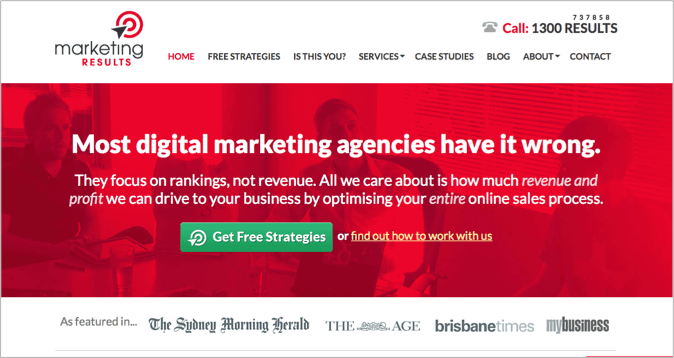
Again, we provide all the competencies necessary to help our clients. But the focus is lead generation.
Clients don’t care that we offer all the services – all they want is qualified leads … and results!
Final USP Thoughts
A well-built USP plays a vital role in keeping visitors on your website and letting prospects know you can solve a problem.
When I’m working with clients, the first step is to write a compelling USP, then base all the marketing around the USP.
